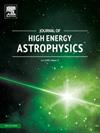Fermi-LAT和FAST对伽马射线双星HESS J0632+057的观测
IF 10.5
4区 物理与天体物理
Q1 ASTRONOMY & ASTROPHYSICS
引用次数: 0
摘要
利用费米大面积望远镜(Fermi- lat) 15年来的数据,我们对伽玛射线双星HESS J0632+057进行了全面的分析。它在0.1 ~ 300 GeV波段的光谱可以用指数为2.40±0.16的幂律模型很好地描述,能量通量为(5.5±1.6)× 10−12 erg cm−2 s−1。HESS J0632+057的GeV光谱能量分布(SED)提示光谱转换在~ 10-100 GeV之间。轨道分析显示在0.2-0.4的相位范围内通量增强,与x射线和TeV光曲线一致,表明一个普通粒子群的起源。利用500米口径球面望远镜(FAST)对HESS J0632+057进行了6次深度射电观测,探测灵敏度达到2μJy。然而,在这些观测中没有检测到无线电脉冲。没有射电脉动可能归因于HESS J0632+057密集的恒星风环境。本文章由计算机程序翻译,如有差异,请以英文原文为准。
Fermi-LAT and FAST observation of the gamma-ray binary HESS J0632+057
Using 15 years of data from the Fermi Large Area Telescope (Fermi-LAT), we performed a comprehensive analysis on the gamma-ray binary HESS J0632+057. Its spectrum in 0.1–300 GeV band is well described by a power law model with an index of , leading to an energy flux of (5.5±1.6)× 10−12 erg cm−2 s−1. The GeV Spectral Energy Distribution (SED) of HESS J0632+057 hints for a spectral turn-over between ∼10-100 GeV. Orbital analysis reveals a flux enhancement during the phase range of 0.2-0.4, consistent with the X-ray and TeV light curves, indicating an origin of a common particle population. We carried out six deep radio observations on HESS J0632+057 with the Five-hundred-meter Aperture Spherical Telescope (FAST), evenly distributed across its orbit, reaching a detection sensitivity of 2μJy. However, no radio pulsation was detected within these observations. The absence of radio pulsation may be attributed to the dense stellar wind environment of HESS J0632+057.
求助全文
通过发布文献求助,成功后即可免费获取论文全文。
去求助
来源期刊

Journal of High Energy Astrophysics
Earth and Planetary Sciences-Space and Planetary Science
CiteScore
9.70
自引率
5.30%
发文量
38
审稿时长
65 days
期刊介绍:
The journal welcomes manuscripts on theoretical models, simulations, and observations of highly energetic astrophysical objects both in our Galaxy and beyond. Among those, black holes at all scales, neutron stars, pulsars and their nebula, binaries, novae and supernovae, their remnants, active galaxies, and clusters are just a few examples. The journal will consider research across the whole electromagnetic spectrum, as well as research using various messengers, such as gravitational waves or neutrinos. Effects of high-energy phenomena on cosmology and star-formation, results from dedicated surveys expanding the knowledge of extreme environments, and astrophysical implications of dark matter are also welcomed topics.
 求助内容:
求助内容: 应助结果提醒方式:
应助结果提醒方式:


